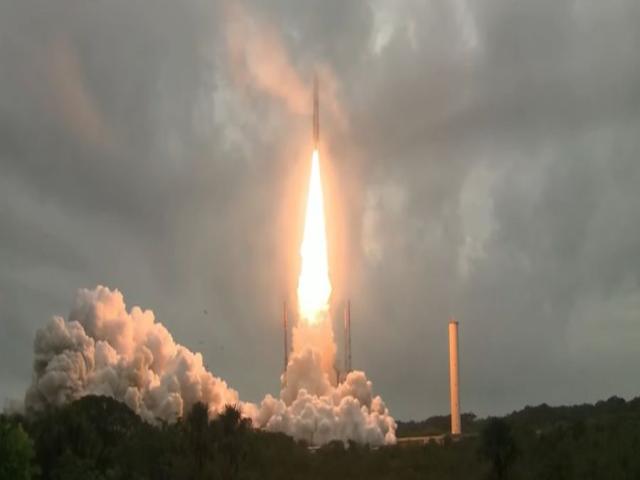The James Webb Space Telescope has successfully launched

The James Webb Space Telescope has successfully launched
It's a moment that has been decades in the making. The James Webb Space Telescope, NASA's premier space observatory of the next decade, successfully launched on Christmas morning.
The telescope lifted off atop an Ariane 5 rocket from Europe's Spaceport in French Guiana at 7:20 a.m. ET.
"We have LIFTOFF of the @NASAWebb Space Telescope!" NASA shared on Twitter. "At 7:20am ET (12:20 UTC), the beginning of a new, exciting decade of science climbed to the sky. Webb's mission to #UnfoldTheUniverse will change our understanding of space as we know it."
The Webb telescope has endured years of delays, including a combination of factors brought on by the pandemic and technical challenges. But the world's most powerful and complex space observatory will answer questions about our solar system, study exoplanets in new ways and look deeper into the universe than we've ever been able to.
The European Space Agency aptly referred to it as "an awesome Christmas present" for the international launch teams, as well as the whole of space science, on Twitter.
NASA Administrator Bill Nelson shared his gratitude for the international teams that made the mission and the Christmas Day launch possible.
"This is a great day for planet Earth," Nelson said shortly after the launch. "Thanks to the team. You all have just been incredible. Over three decades, you produced this telescope that is now going to take us back to the very beginnings of the universe. We are going to discover incredible things that we never imagined."
Webb will peer into the very atmospheres of exoplanets, some of which are potentially habitable, and it could uncover clues in the ongoing search for life outside of Earth.
The telescope comes equipped with a mirror that can extend 21 feet and 4 inches (6.5 meters) -- a massive length that will allow the mirror to collect more light from the objects it observes once the telescope is in space. The more light the mirror can collect, the more details the telescope can observe.
The mirror includes 18 hexagonal gold-coated segments, each 4.3 feet (1.32 meters) in diameter.
It's the largest mirror NASA has ever built, the agency said, but its size created a unique problem. The mirror was so large that it couldn't fit inside a rocket. So the NASA team designed the telescope as a series of moving parts that can fold origami-style and fit inside a 16-foot (5-meter) space for launch.
Webb will act as an infrared detective, detecting light that is invisible to us and revealing otherwise hidden regions of space, according to NASA.Ball Aerospace optical technician Scott Murray inspects the first gold primary mirror segment of the telescope.
Since 2004, thousands of scientists, technicians and engineers from 14 countries have spent 40 million hours building the telescope. The telescope includes instruments from the Canadian Space Agency and the European Space Agency.
Now, Webb is ready to help us understand the origins of the universe and begin to answer key questions about our existence, such as where we came from and if we're alone in the cosmos.
The Webb telescope will look at every phase of cosmic history, including the first glows after the big bang that created our universe and the formation of the galaxies, stars and planets that fill it today. Its capabilities will enable the observatory to answer questions about our own solar system and investigate faint signals from the first galaxies formed 13.5 billion years ago.
The telescope will take a closer look at a selection of exoplanets to peer inside their atmospheres, if they have them, and help answer questions about how the planets formed and evolved. Data collected by the telescope can tell scientists if methane, carbon dioxide or carbon monoxide is in the atmosphere. The gases within these alien atmospheres could reveal the very building blocks of life.
Other objects of interest for the initial science campaign include observing the supermassive black hole at the center of the Milky Way, actively forming planetary systems, bright quasars at the center of galaxies, and leftovers from the formation of our solar system known as Kuiper Belt Objects.
With all of its superlatives, engineering Webb was an extraordinary challenge. The observatory is comprised of three main elements.
One is the Integrated Science Instrument Module, which holds Webb's suite of four instruments. These instruments will mainly be used for capturing images or spectroscopy -- breaking down light into different wavelengths to determine physical and chemical components.
The main eye of the observatory, called the Optical Telescope Element, includes the mirrors and backplane, or spine, that supports the mirrors. And then there's the Spacecraft Element, which includes the spacecraft bus and sunshield
The spacecraft bus includes the six main subsystems needed to operate the spacecraft, including propulsion, electrical power, communication, data and thermal controls. This "bus" design, which doesn't actually resemble a bus, is used to support the spacecraft's infrastructure.
The five-layer sunshield unfurls to reach the size of a tennis court and it will protect Webb's giant mirror and instruments from the sun's heat -- because they need to be kept at a very frigid negative 370 degrees Fahrenheit (negative 188 degrees Celsius) to operate.
The observatory will travel for about a month until it reaches an orbit about 1 million miles (1.6 million kilometers) away from Earth. During those 29 days, Webb will unfold its mirrors and unfurl the sunshield. This process involves thousands of parts that must work perfectly in the right sequence.
Fortunately, each step can be controlled from the ground in case there are issues.
And then it will go through a period of commissioning in space that lasts for six months. That includes cooling down the instruments, alignment and calibration. All of the instruments will go through a checkout process to see how they're functioning.
"The launch of the Webb Space Telescope is a pivotal moment -- this is just the beginning for the Webb mission," said Gregory L. Robinson, Webb's program director at NASA Headquarters, in a statement.
"Now we will watch Webb's highly anticipated and critical 29 days on the edge. When the spacecraft unfurls in space, Webb will undergo the most difficult and complex deployment sequence ever attempted in space. Once commissioning is complete, we will see awe-inspiring images that will capture our imagination."
Webb will begin to collect data and its first images later in 2022. Thousands of scientists have been waiting for years to see what the observatory can show us.
"The initial year of Webb's observations will provide the first opportunity for a diverse range of scientists around the world to observe particular targets with NASA's next great space observatory," said Thomas Zurbuchen, associate administrator for the Science Mission Directorate at NASA, in a statement.
"The amazing science that will be shared with the global community will be audacious and profound."

API Security: What It Is, Why It Is Important, and the Best Practices in 2022
- A description of API security, as well as reasons for its importance and best practises for the year 2022.

Crackle – Free Movies and TV shows for Android TV
- Entertainment often leaves us delighted and content. Not only does it help one to spend their leisure time relaxed

Why are electronic receipt & invoices important nowadays?
- As of late, on the off chance that we look at our lives years and years prior, we have a conspicuous incentive for our paper solicitations

Unlocking Efficient Crawling: Notifying Google of URL Updates
- Learn how to leverage Googles Indexing API to notify the search engine of new URLs or updates, optimizing crawling and indexing.